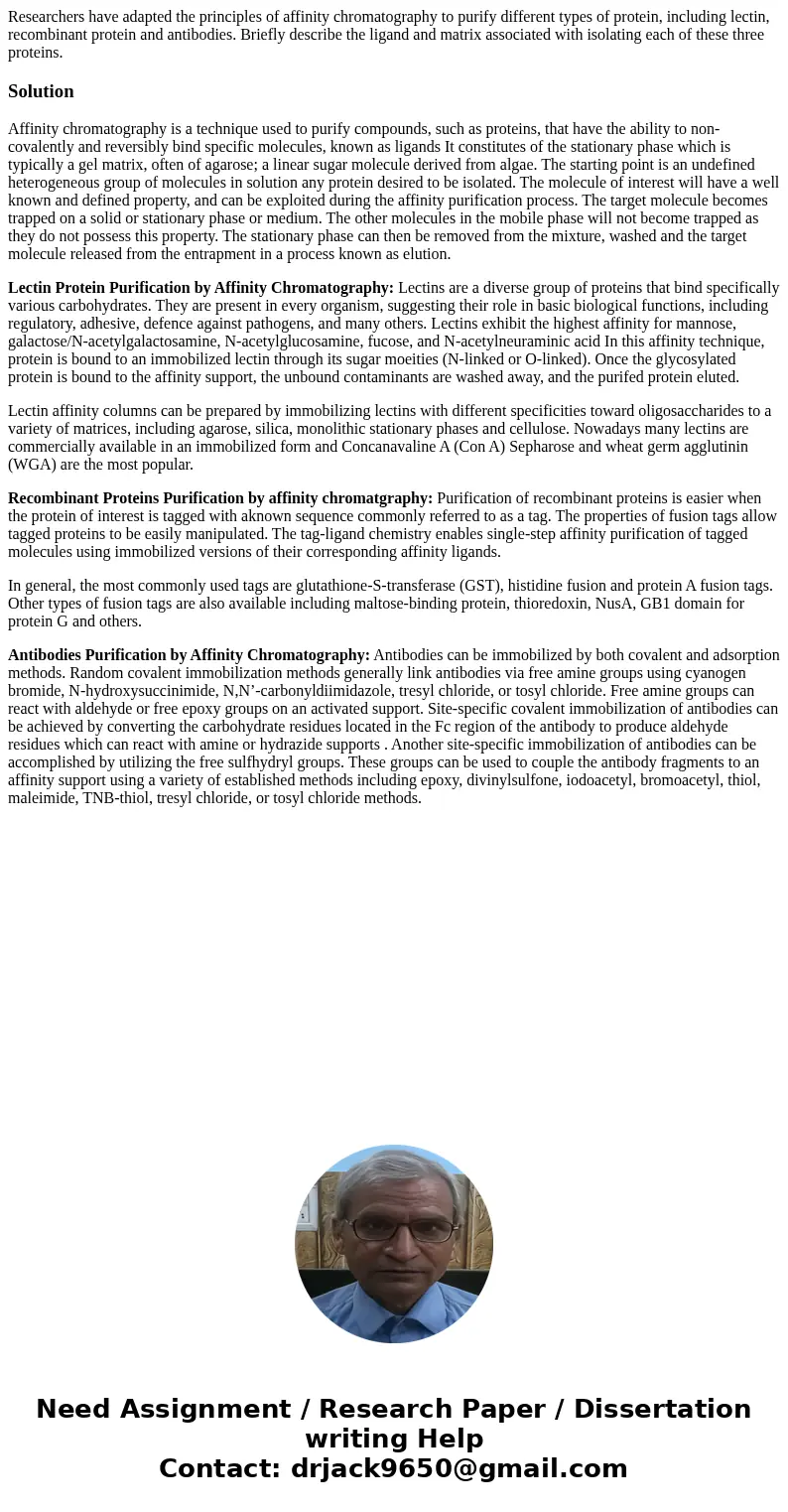Researchers have adapted the principles of affinity chromato
Researchers have adapted the principles of affinity chromatography to purify different types of protein, including lectin, recombinant protein and antibodies. Briefly describe the ligand and matrix associated with isolating each of these three proteins.
Solution
Affinity chromatography is a technique used to purify compounds, such as proteins, that have the ability to non-covalently and reversibly bind specific molecules, known as ligands It constitutes of the stationary phase which is typically a gel matrix, often of agarose; a linear sugar molecule derived from algae. The starting point is an undefined heterogeneous group of molecules in solution any protein desired to be isolated. The molecule of interest will have a well known and defined property, and can be exploited during the affinity purification process. The target molecule becomes trapped on a solid or stationary phase or medium. The other molecules in the mobile phase will not become trapped as they do not possess this property. The stationary phase can then be removed from the mixture, washed and the target molecule released from the entrapment in a process known as elution.
Lectin Protein Purification by Affinity Chromatography: Lectins are a diverse group of proteins that bind specifically various carbohydrates. They are present in every organism, suggesting their role in basic biological functions, including regulatory, adhesive, defence against pathogens, and many others. Lectins exhibit the highest affinity for mannose, galactose/N-acetylgalactosamine, N-acetylglucosamine, fucose, and N-acetylneuraminic acid In this affinity technique, protein is bound to an immobilized lectin through its sugar moeities (N-linked or O-linked). Once the glycosylated protein is bound to the affinity support, the unbound contaminants are washed away, and the purifed protein eluted.
Lectin affinity columns can be prepared by immobilizing lectins with different specificities toward oligosaccharides to a variety of matrices, including agarose, silica, monolithic stationary phases and cellulose. Nowadays many lectins are commercially available in an immobilized form and Concanavaline A (Con A) Sepharose and wheat germ agglutinin (WGA) are the most popular.
Recombinant Proteins Purification by affinity chromatgraphy: Purification of recombinant proteins is easier when the protein of interest is tagged with aknown sequence commonly referred to as a tag. The properties of fusion tags allow tagged proteins to be easily manipulated. The tag-ligand chemistry enables single-step affinity purification of tagged molecules using immobilized versions of their corresponding affinity ligands.
In general, the most commonly used tags are glutathione-S-transferase (GST), histidine fusion and protein A fusion tags. Other types of fusion tags are also available including maltose-binding protein, thioredoxin, NusA, GB1 domain for protein G and others.
Antibodies Purification by Affinity Chromatography: Antibodies can be immobilized by both covalent and adsorption methods. Random covalent immobilization methods generally link antibodies via free amine groups using cyanogen bromide, N-hydroxysuccinimide, N,N’-carbonyldiimidazole, tresyl chloride, or tosyl chloride. Free amine groups can react with aldehyde or free epoxy groups on an activated support. Site-specific covalent immobilization of antibodies can be achieved by converting the carbohydrate residues located in the Fc region of the antibody to produce aldehyde residues which can react with amine or hydrazide supports . Another site-specific immobilization of antibodies can be accomplished by utilizing the free sulfhydryl groups. These groups can be used to couple the antibody fragments to an affinity support using a variety of established methods including epoxy, divinylsulfone, iodoacetyl, bromoacetyl, thiol, maleimide, TNB-thiol, tresyl chloride, or tosyl chloride methods.

 Homework Sourse
Homework Sourse